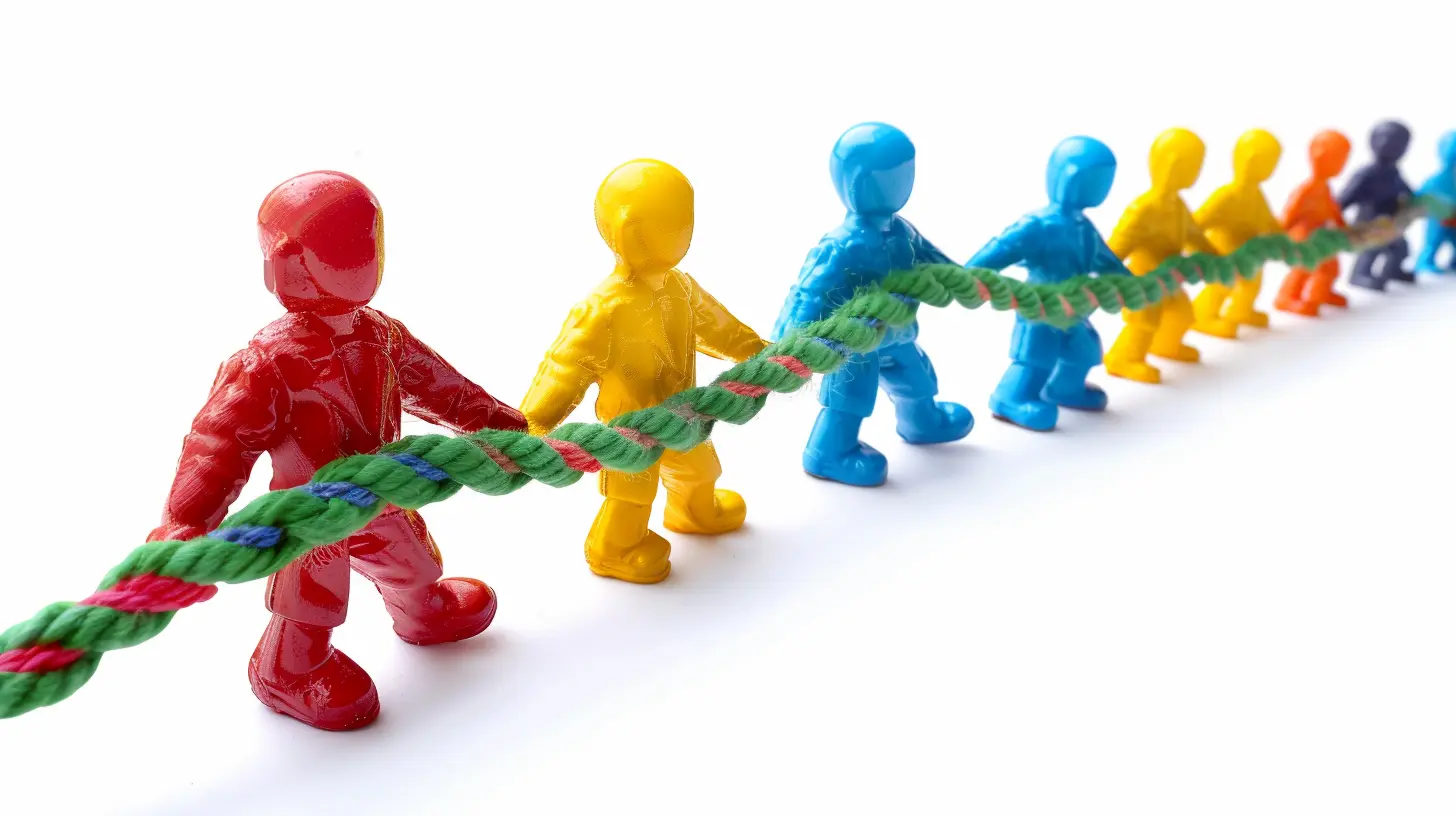Building Teams That Collaborate Across Generations
7 June 2025
Let’s face it – the workplace isn’t what it used to be. Gone are the days where everyone in the office came from similar backgrounds, dressed the same, and thought the same way. Today, you’re just as likely to be in a meeting with a 23-year-old TikTok influencer turned marketing manager as you are with a 65-year-old sales veteran who’s been closing deals longer than the internet’s existed.
Sounds like a recipe for disaster, right?
Wrong. When done right, building teams that collaborate across generations is not just possible – it's powerful. It’s the difference between a company stuck in its ways and one that’s adaptable, innovative, and ahead of the curve.
So, how do we actually make it happen? How do you get Baby Boomers, Gen Xers, Millennials, and Gen Zers to stop throwing side-eyes and start sharing ideas?
Let’s break it all down.
Understanding the Generational Divide (And Why It’s Not a Bad Thing)
Before we can unite generations, we have to understand what makes each one tick. Here’s the cheat sheet:- Baby Boomers (Born 1946–1964): Loyal, hardworking, enjoy structure, love face-to-face interaction.
- Gen X (Born 1965–1980): Independent, skeptical, value work-life balance, grew up with landlines.
- Millennials (Born 1981–1996): Tech-savvy, purpose-driven, crave feedback, grew up in a digital boom.
- Gen Z (Born 1997–2012): Digital natives, entrepreneurial, socially aware, love flexibility and freedom.
Instead of thinking, "They're so different, how will this ever work?" try flipping the script. The magic happens in the mix. Think of it like a great potluck – every generation brings something unique to the table, and together, the feast is fire.
1. Drop the Labels and Start with People
Real talk: Labels suck. Nobody wants to walk into a room and be treated like a “Millennial stereotype” or the “old guy who doesn’t understand TikTok.”If we want multi-generational teams to thrive, we need to stop generalizing and start personalizing. Everyone has their own set of talents, values, and preferences — and that doesn’t always line up with their birth year.
Action Tip: Ask questions, listen actively, and understand individual motivations. You’d be surprised how much Gen Z and Boomers might actually agree on… like hating long meetings.
2. Build a Culture That Encourages Cross-Generational Mentoring
Mentoring isn’t just for the junior staff anymore. Reverse mentoring is real, and it's changing the game.- Boomers have decades of industry knowledge, negotiation skills, and relationship-building.
- Gen Z brings cutting-edge tech knowledge, social media savviness, and fresh perspectives.
When you pair these strengths, you create an unstoppable dynamic.
Action Tip: Set up informal mentorship pairings (in both directions). This shouldn’t be some stiff, corporate program. Think more coffee chats than quarterly reviews.
3. Gear Your Communication Style for Everyone, Not Just One Group
Communication is where teams often break down. While some folks love in-depth email chains, others won’t check their inbox unless the subject line screams “URGENT.”Want better collaboration fast? Meet people where they are.
- Use a mix of communication styles — Slack, email, video, phone calls — and let the team choose what works best.
- Avoid over-complicating things. Whether you’re 24 or 64, nobody wants to read a novel-length message to confirm a 3 PM meeting.
Pro Tip: Emojis aren’t unprofessional. They can add tone and help avoid misinterpretations. A thumbs-up goes a long way.
4. Leverage Strengths Instead of Fixating on Weaknesses
Every generation has strengths — but if you're only seeing the flaws, you're missing the gold.- Millennials aren’t “entitled” — they push for purpose and transparency.
- Boomers aren’t “resistant to change” — they're cautious and experienced.
- Gen Z isn’t “always on their phones” — they’re masters of rapid learning.
- Gen X isn’t “forgotten” — they’re the glue holding most organizations together.
Action Tip: Sit down with your team and map out key strengths. Ask what each person believes they bring to the group. You’ll be amazed by the results.
5. Design Workflows That Include Everyone’s Learning Curve
Let’s not pretend everyone learns the same way. While Boomers might prefer a hands-on workshop, Gen Z may learn better through a short, punchy TikTok-style training video. And guess what? Both are valid.Action Tip: Offer multiple formats for training and communication. Record meetings. Create visual and written SOPs. Provide opportunities for hands-on learning. Flexibility isn’t a perk anymore—it’s a necessity.
6. Create Shared Goals (And Celebrate Wins Together)
You want everyone rowing in the same direction? Give them a reason to row.Generational divides often shrink when people unite around a common mission. Shared goals create context, clarity, and connection.
Better yet? Celebrate wins as a team. Whether it’s a Slack shout-out, an impromptu team lunch, or just a simple “great job” at the end of the day—recognition never goes out of style.
Pro Tip: Make celebrations inclusive. Not everyone drinks, wants to party, or enjoys public praise. Ask your team what they enjoy and tailor accordingly.
7. Tackle Bias Head-On (Even the Subtle Stuff)
Let’s address the elephant in the Zoom call: age-related bias exists. Younger employees might feel ignored. Older ones may feel undervalued.The worst part? A lot of it is unconscious.
If you're not actively working to eliminate bias, it's probably bubbling under the surface. That sarcasm about “those Boomers” or “kids these days” might seem harmless—but it chips away at trust and collaboration.
Action Tip: Run regular team check-ins focused on inclusion and respect. Encourage anonymous feedback. Create safe spaces for hard conversations and course correct when needed.
8. Use Tech That Works for All Generations
Let’s be clear: tech can unite or divide. The right tools bring people together. The wrong ones create headaches, confusion, and resentment.Choose platforms that are:
- Easy to learn
- Intuitive to use
- Reliable, not clunky
- Supported by tutorials or onboarding sessions
Pro Tip: Don’t assume everyone is fluent in your favorite software. Offer basic training, create cheat sheets, and make it okay to ask “silly” questions. Tech confidence shouldn’t be a generational privilege.
9. Build Psychological Safety into the DNA of the Team
Want your multi-generational team to thrive? They need to feel safe — not just physically, but emotionally.Psychological safety is the bedrock of collaboration. It means your team feels okay being themselves, speaking up, asking questions, and challenging ideas without fear of shame or backlash.
Action Tip: As a leader, model vulnerability. Admit when you don’t know something. Say “good point” even if it comes from the intern. Make it clear that input is valued, not just tolerated.
10. Create Opportunities for Purpose-Driven Collaboration
People don’t just want to clock in and clock out anymore. They want to feel like what they’re doing matters.This is something all generations crave — they just express it differently.
- Boomers may want to leave behind a legacy.
- Millennials want to make an impact.
- Gen Z wants to drive change.
- Gen X wants stability with meaning.
When you create projects that serve a bigger purpose — something beyond profit — you light a fire under the entire team.
Pro Tip: Set up cross-functional, cross-generational project squads. Give them ownership. Let them innovate. Then get out of the way.
Final Thoughts: Embrace the Generational Mosaic
Diversity of age isn’t a problem to be fixed. It’s a tool to be sharpened.A team that spans generations is like a playlist that includes classics, deep cuts, and fresh drops. It doesn’t clash — it builds depth. It tells a story. It surprises and delights.
Let’s stop trying to force everyone into the same mold and start embracing the mosaic. Mix the wisdom of age with the energy of youth. Blend tradition with innovation. And watch your team transform from disconnected to dynamic.
In the end, it’s not about the generation. It’s about the collaboration.
So, are you ready to build a team that turns diversity into its greatest asset?
Let’s go.
all images in this post were generated using AI tools
Category:
Team BuildingAuthor:

Matthew Scott
Discussion
rate this article
2 comments
Selah McIlroy
Creating a collaborative environment across generations fosters understanding and innovation. Embracing diverse perspectives not only enhances teamwork but also cultivates a culture of respect and growth for everyone involved.
June 12, 2025 at 3:28 AM

Matthew Scott
Absolutely! Embracing diverse perspectives is key to fostering innovation and respect in collaborative teams. It enriches the workplace and drives growth for all generations involved. Thank you for your insightful comment!
Julian Patterson
Effective collaboration thrives on embracing diverse generational strengths—it's the key to innovation and team success.
June 11, 2025 at 3:31 AM

Matthew Scott
Absolutely! Embracing generational diversity enhances creativity and problem-solving, driving innovation and overall team success.


